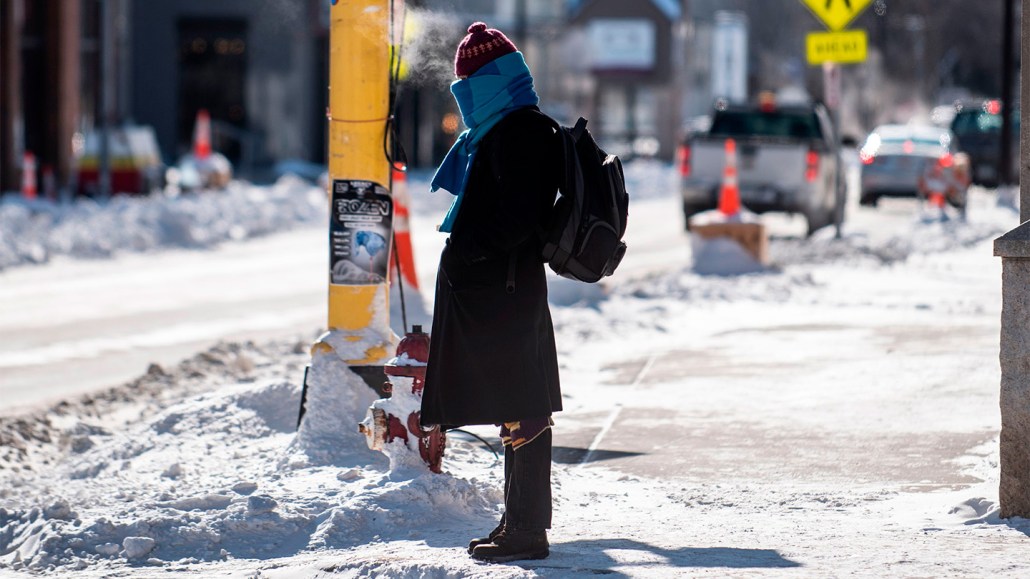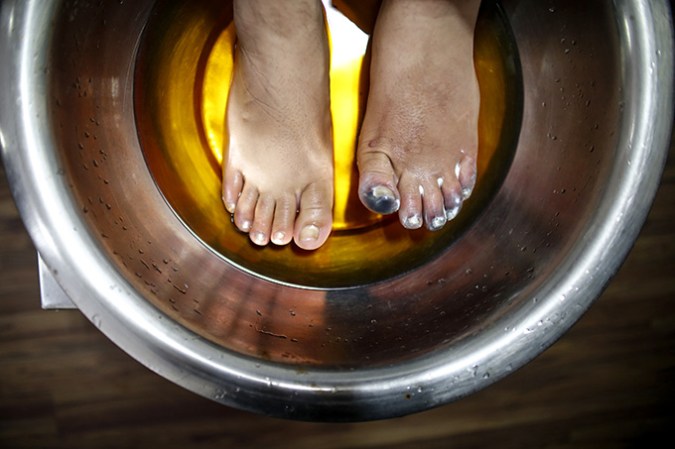The U.S. now has a drug for severe frostbite. How does it work?
Approved by the FDA in February, iloprost can prevent the need to amputate frozen fingers and toes

Bundled in layers of warm clothing, a pedestrian in Minneapolis braves a day that was so bitterly cold that officials warned of a heightened risk of frostbite. A newly FDA-approved drug, iloprost, can help to treat severe frostbite.
STEPHEN MATUREN/AFP via Getty Images
In the worst cases, frostbite can cause the tissues in fingers, toes, noses and other extremities to die and require amputation. Now doctors in the United States have a way to save patients from these life-altering effects.
In February, the U.S. Food and Drug Administration approved the country’s first medication to treat severe frostbite. In a clinical trial, the drug, iloprost, greatly reduced amputations in nearly all the frostbite patients who received it.
Although frostbite affects a relatively small number of people in the United States — a few thousand annually — it is a major concern for people who must spend a lot of time outside in the cold, such as mountain climbers, people in the military and people without housing.
A synthetic drug first developed in Germany in 1980s, iloprost, also known by the brand name Aurlumyn, is given by injection. It works as a vasodilator, meaning it widens blood vessels, improves blood flow and prevents risk of blood clotting. It was primarily used to treat Raynaud’s disease, a disorder that causes blood vessels in the fingers and toes to narrow, as well as to treat blood pressure–related illnesses.
A study published in 1994 was the first to test if the drug may also be able to open up jammed blood vessels as a result of frostbite. It was tested in five patients, successfully recovering their frostbitten digits in all cases.
The drug subsequently showed promising results in studies done in England, France and Nepal. In the clinical trial cited by the FDA in its approval of iloprost, patients rescued from high altitudes were randomly assigned to treatment with either buflomedil (another vasodilator), iloprost or iloprost plus a drug that breaks down blood clots. Out of the 47 patients treated over 12 years, none of the 16 patients that received iloprost alone had to have digits amputated, researchers reported in 2011 in the New England Journal of Medicine. In comparison, nine of 15 patients in the buflomedil group needed amputations as did three of 16 patients in the iloprost combination group.
Iloprost is already an approved treatment for frostbite for years in a number of European countries and elsewhere in the world. Science News talked with Chris Imray, a vascular surgeon at University Hospitals Coventry & Warwickshire in England who has been treating patients with this drug for more than a decade, about what frostbite does to the body, how the drug works and what it will mean for patient treatment in the United States. The interview has been edited for length and clarity.
SN: What happens in the body during frostbite?
Imray: Frostbite is a thermal injury that affects [the] hands, feet, nose, ears and occasionally external genitalia after a few hours of cold exposure. When the temperature of the tissue drops to around zero degree Celsius, the blood flow through the tissue slows down. Then you get thrombosis, clots forming within the blood vessels, which subsequently leads to loss of oxygen delivery to the tissue. Over a period of time, you then get gangrene and the tissue dies.
SN: How did scientists realize that targeting blood clotting can be useful in frostbite treatment?
Imray: If we’ve got a tissue that’s damaged from a thermal injury with poor blood supply, you could try to treat by warming the tissue. But the problem is that if there’s no blood supply, you may warm up the tissue but you won’t restore the oxygen delivery to the tissue, and that actually just speeds up the deterioration.
We’ve known for some time in other situations, like stroke or acute coronary syndromes, that if you can restore the blood quickly, within four to six hours, you can restore the blood supply, clear the clots in the small blood vessels, and then oxygen is delivered to the tissues again. One of the treatments for acute coronary syndrome was thrombolytic agents to break down the clot. But if a patient had an accident and has soft tissue or bony injuries, giving them thrombolytic agents may cause more bleeding. Iloprost works as a vasodilator rather than as a lytic agent on the clot. That’s really sort of where it came from.

SN: How has iloprost changed treatment of frostbite?
Imray: We used to do something called a sympathectomy. Vascular surgeons would cut the sympathetic nerves to open up the blood vessels to the hands or to the feet. Once [iloprost] came out, it seemed to have a similar effect — it would cause the blood vessels to vasodilate. The beauty was you didn’t have to cut the nerves permanently.
SN: How is iloprost administered?
Imray: The drug is given intravenously and circulates all through the body. We often start at a low dose and then gradually increase the infusion rate, until the patient starts to get side effects — facial flushing, high heart rate or low blood pressure. At that point, we wind it back a very small amount — just enough to get rid of the symptoms. Then we run it for six hours [and repeat] the process for around five days. We can do imaging tests to see if there’s an improvement to the blood supply to the tissues. Then the surgeons will need to manage the tissues that have been almost dead and brought back to life. The overall effect is a dramatic limb and digit salvage rate, which is quite remarkable.
SN: How does iloprost work?
There are multiple mechanisms that have been put forward for it. One is vasodilation. One is that it seems to affect clotting slightly. And it changes the [ability] of the red blood cells to get through the small vessels.
SN: What timing is crucial for treating frostbite?
Imray: All tissues have different metabolic rates. The brain has a very high metabolic rate, which is why [there’s] a short window, about six hours, to [break down blood clots] in a stroke. The heart has a little bit longer. And if you don’t get there within that time, the person has permanent tissue damage.
We’re not really sure about tissues in the hands, feet and muscles. We thought [within] 24 hours was the maximum time [after frostbite injury for using iloprost], but there have been reports of some people who have gone as long as five days. But the longer you go for the type of injury, the less impressive the effects will be.
SN: Who will this new approval benefit most?
Imray: We’ve had a number of high-profile climbers who have had [frostbite] injuries where they’ve been told there’s nothing that can be done. And they subsequently lost tissue. So, what we’re trying to do is to identify medical units [close to the big mountains] where iloprost can be given, so that if you have an injury, you can be flown there as quickly as possible.
Frostbite also affects homeless people. Sadly, they don’t generate the same concern [as the high-profile climbers], but they can have serious frostbite injuries and end up with life-changing amputations.
If you look at people who would be at risk of losing limbs, [the iloprost approval] will transform that. I’m delighted [the FDA has] approved it, but they’ve taken quite a long time to get there.







